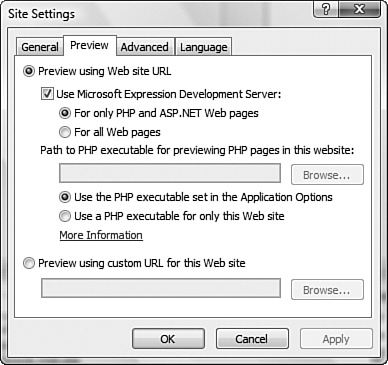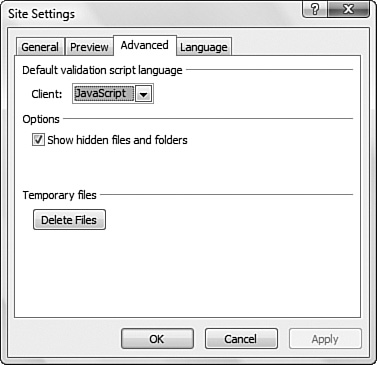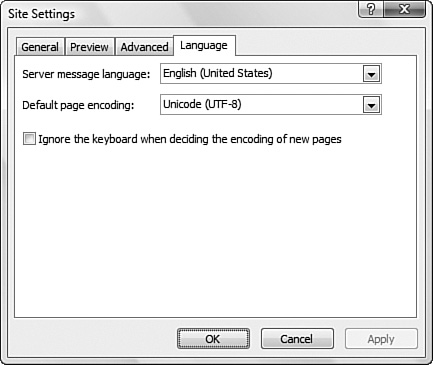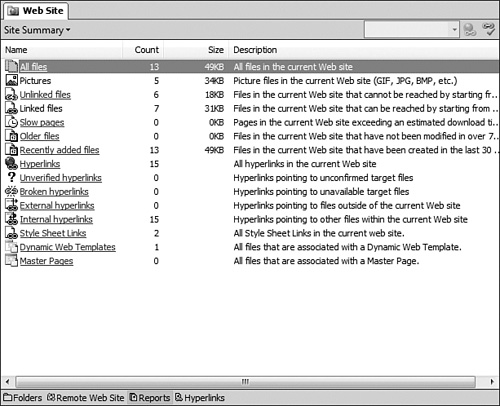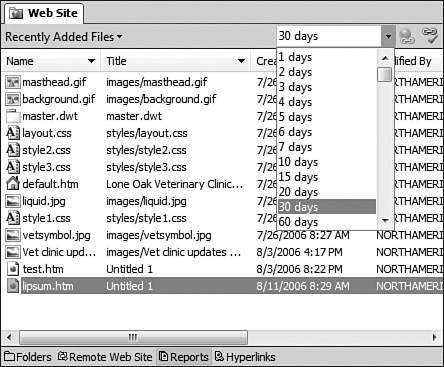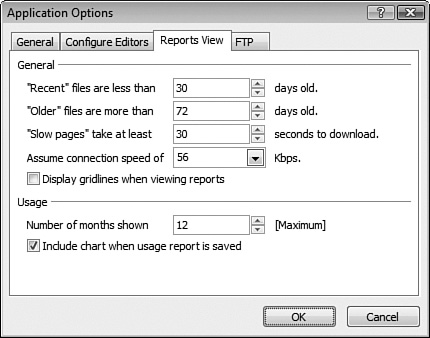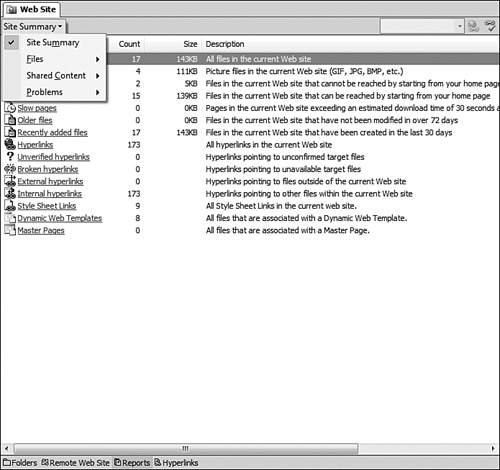While Expression Web 2 can certainly be used to create and edit single Web pages, it really shines when used to create and managing entire Web sites.
Several configuration settings in Expression Web 2 are designed to affect an entire Web site. These settings are available in the Site Settings dialog shown in Figure 4.1.
Tip
If you have a remote Web site open in Expression Web 2, you may experience a delay of several seconds before the Site Settings dialog appears. The FrontPage Server Extensions have to read the site’s entire configuration before the dialog is displayed.
This delay is not experienced with disk-based Web sites.
To access the Site Settings dialog, select Site, Site Settings. There are four tabs in the Site Settings dialog.
The General tab displays general information about the Web site and allows you to change the name of the Web site and configure the use of metadata.
→ | For more information on metadata, see Chapter 2, “Creating a Web Site,” p. 27. |
When you change a Web site’s name in the General tab, the folder name changes as well. If the Web site is server-based, the URL for the Web site will change too.
The Preview tab configures how Web pages should be previewed, as shown in Figure 4.2. You can choose to preview using a Web site’s path (including using the Microsoft Expression Development Server for ASP.NET or PHP pages) or a custom URL.
For more information on using and configuring the Microsoft Expression Development Server, see Chapter 27, “Using the Microsoft Expression Development Server,” p. 483. |
If you are using the Microsoft Expression Development Server to serve PHP pages, you can also use the Preview tab to configure the version of PHP that should be used. You’ll want to make sure you are using the same version of PHP here that you will be using on the production server.
Tip
If you are using PHP on a Windows server, use IIS 7 if possible because it provides much better PHP performance than other versions of IIS.
→ | For more information on using PHP with Expression Web 2, see Chapter 35, “Using PHP in Expression Web 2,” p. 643. |
Using a custom URL is convenient when you need to use a different URL for previewing than the URL used to open the site in Expression Web 2. For example, if you are using a disk path in Expression Web 2 for a Web site located on a Web server, you can enter an HTTP path for the custom URL that maps to the disk location used by Expression Web 2. When pages are previewed in Expression Web 2, they will be opened using the URL you specify.
The Advanced tab (shown in Figure 4.3) configures the language used for form field validation, determines whether hidden files and folders will be visible, and allows for the deletion of temporary files.
Note
There is also a Client drop-down on the Advanced tab for setting the language used for the default validation script language. Because Expression Web 2 doesn’t provide client validation features for form fields, I spoke to Microsoft about this drop-down. They explained to me that the drop-down isn’t functional at this point and will be removed in future versions.
By default, hidden files and folders are not visible in the Folder List and other Expression Web 2 views. (This also includes metadata in _vti folders.) If you’d like to be able to see these hidden files and folders, check the Show Hidden Files and Folders check box and click OK. When you do, Expression Web 2 will ask if you want to refresh the Web site. Click Yes and you will see hidden files and folders appear in Expression Web 2.
The Delete Files button will delete temporary files that are created for Expression Web 2 to keep track of your Web site. While these files don’t take up much room on your hard drive, they can become corrupted and cause strange behavior. Deleting them periodically is a good idea for this reason.
Tip
One of the symptoms of corrupt temporary files is a Web site that won’t open. Many times, this kind of problem results in constant disk activity until the Windows swap file fills up and you run out of disk space.
If you run into a problem like this and can’t open a site to delete temporary files, you can manually delete the files. They are located in C:Users<user>AppDataRoamingMicrosoftWeb Server ExtensionsCache on Windows Vista and Documents and Settings<user>Application DataMicrosoftWeb Server ExtensionsCache on Windows XP. Make sure Expression Web 2 is closed, and then delete all files with a .web file extension.
The Language tab (shown in Figure 4.4) configures the language used for server messages and defines the encoding used for Web pages.
The setting in the Server Message Language drop-down applies only to FrontPage Server Extensions messages. If the Web site opened in Expression Web 2 is not a FrontPage Server Extensions-based Web site, the Server Message Language drop-down will contain only English as an option.
Note

If you make a change to page encoding and it’s not reflected in your pages, see “Page Encoding Doesn’t Affect Pages” in the “Troubleshooting” section of this chapter.
The Default Page Encoding drop-down configures the character set specified in the content-type META tag added to Web pages. The browser uses page encoding to determine which character set to use. When the character set is incorrect, the page does not display correctly.
Expression Web 2 uses a default setting of utf-8 (Unicode), which supports all languages and is the correct encoding for XHTML documents.
→ | For more information on XHTML, see Chapter 19, “Accessibility Features in Expression Web 2,” p. 343. |
One of Expression Web 2’s greatest strengths is in the area of site management. The large array of reports available makes managing a site easier by providing indicators of problems and giving details on other aspects of your Web site.
The Site Summary view provides a link to some of the reports in Expression Web 2 and also summarizes information about the site. To view the Site Summary (shown in Figure 4.5), select Site, Reports, Site Summary.
To access all the reports in Expression Web 2, select Site, Reports and choose the desired report. The following reports are available in Expression Web 2:
All Files—. Displays all files in the Web site in a single view. This report also shows the title, location, and other properties of each file.
Recently Added Files—. Displays all files recently added to the Web site. As shown in Figure 4.6, you can select a specific number of days to display files added within that number of days.
Recently Changed Files—. Displays all files that have recently changed. Just as with the Recently Added Files report, you can select a specific number of days to display files that have changed within that number of days.
Older Files—. Displays all files older than 72 days by default. The number of days can be adjusted using the Report Setting drop-down.
Checkout Status—. Displays the checkout status of files and shows who (if anyone) has each file checked out.
Dynamic Web Templates—. Shows all Dynamic Web Templates and their file connections.
→
For more information on Dynamic Web Templates, see Chapter 21, “Using Dynamic Web Templates,” p. 367.
Master Pages—. Displays all files and any master pages used by each file.
→
For more information on Master Pages, see Chapter 29, “Using ASP.NET Navigation Controls,” p. 523.
Style Sheet Links—. Displays all pages and any style sheets linked to them.
→
For more information on using style sheet links, see Chapter 18, “Managing CSS Styles,” p. 315.
Unlinked Files—. Shows all files that are not linked to by links that can be followed from the home page.
Slow Pages—. Displays all pages that will take longer than 30 seconds to load by default. The time threshold can be adjusted using the Report Setting drop-down.
Hyperlinks—. Displays the status of each hyperlink. Hyperlinks can be checked or edited using the Verify Hyperlink, respectively, as shown in Figure 4.7.
Review Status—. Shows the review status for each file in the site. This report also shows to whom each file is assigned.
Assigned To—. Similar to the Review Status report, this report shows to whom each file is assigned for review.
Categories—. Displays each page and the category (if applicable) to which it is assigned.
Publish Status—. Displays the publish status of each file in the Web site. If a file is configured to not publish with the rest of the site, it will be labeled as Don’t Publish in this report.
Using these comprehensive reports, you can maintain tight control over the files in your Web site.
The reports in Expression Web 2 are generated using some preset defaults. For example, the download speed of a page assumes a 56k connection by default, and the Recent Files report lists files that are fewer than 30 days old by default. You can configure these defaults by selecting Tools, Application Options to access the Application Options dialog shown in Figure 4.8.
After viewing a specific report, you can return to the Site Summary view by clicking the name of the current report in the upper-left corner of the main window and selecting Site Summary, as shown in Figure 4.9.
To share an Expression Web 2 report with another designer, you can easily save any report as an HTML file. Simply display the report and then select File, Save to save the report as an HTML file.
Expression Web 2 defaults to saving the report in the current Web site, but you can specify any location.
Expression Web 2’s reporting features are great for giving you a broad overview of your Web site. However, if you want verbose data on your Web site, you’ll want to use a different method.
Your Web host almost certainly provides logging features that you can take advantage of. Some hosting companies charge an extra sum for access to logging information via a Web interface, but many offer access to log information at no charge.
If you want a great method of tracking Web site traffic that’s perfectly free, Google offers a service called Google Analytics. By placing a small bit of hidden code on your Web site, you can enable Google to keep detailed tracking information of your Web site, how people are finding you, and how many visitors you’re seeing, in addition to much more valuable information.
Google Analytics is available free from www.google.com/analytics.


